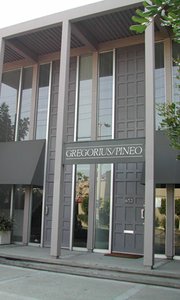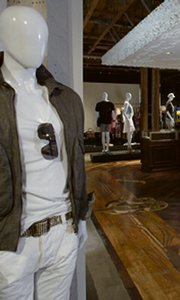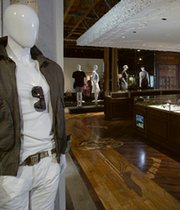The Changing Face of Melrose Place
When fashion designer Catherine Malandrino opens her next store in Los Angeles in December, she will be gambling on a fashion neighborhood that is at a crossroads.
Malandrino’s self-named store will be located at 653 N. La Cienega Blvd. It directly faces Melrose Place, a small, secluded road that is sandwiched behind busy Melrose Avenue and one of Los Angeles’ major traffic arteries, La Cienega Boulevard. When the Malandrino store debuts, it will gain access to a unique, burgeoning fashion community on Melrose Place that juggles prominence and privacy.
In the past two years, the small street has become the address for the boutiques of some big names in fashion, Oscar De La Renta, Carolina Herrera, Marni and Marc Jacobs.
However, some business people charting the growth of the street wonder if the marriage of high fashion and an isolated street is a mismatch.
While prominent fashion brands often choose real estate in an area that is crowded with shoppers, Melrose Place is unique. The isolated tree-lined street is an oasis of calm in the bustle of Los Angeles. The street’s boosters concede that it might never attract big crowds. It is a destination shopping street that consumers must make an effort to find. However, Melrose Place is currently one of the most sought-after retail addresses in the city.
Most of the street’s old guard of antiquesand furniture-store tenants have moved. Real estate executive Chuck Dembo, a partner in Beverly Hills–based Dembo & Associates, estimated that 10 percent of the street’s commercial space was available as of the last week of July. And these spaces might be leased quickly.
The new neighbors are some of the fashion world’s blue-chip names, and the rents are relatively cheap compared tenants to other shopping locales in the city. A square foot of commercial space on Melrose Place goes for $15, according to Dembo. A square foot of commercial space on Rodeo Drive is $40. And on the most sought-after blocks of Robertson Boulevard, rents go for about $20 per square foot.
The street’s draw attracted footwear and accessories brand Sergio Rossi to pull up its stakes from the world-famous Rodeo Drive. Sergio Rossi will open its new place on Melrose Place by November. Italian denim label Diesel chose the place to open a 3,500- square-foot flagship store, where 90 percent of its wares will represent the label’s most innovative looks, according to Renzo Rosso, the president and founder of Diesel.
The street also will give Catherine Malandrino a chance to do something new, according to a representative of the fashion designer.
Plans for the Malandrino store have not been finished, but the space may include a cafeacute; and a homeware section, as well as her two collections: the designer Malandrino Collection and the contemporary Catherine Malandrino Collection. The Malandrino store will fill a two-story building, which until recently served as the headquarters of the Gregorius/Pineo furniture designers. She also runs a boutique at 8644 Sunset Blvd. in Los Angeles.
Rosso chose to build the Diesel flagship on this small street to try fresh ideas. “The opening of the Melrose flagship is especially significant to us,” Rosso said. “It represents the first time that we are able to express our design aesthetic more freely.”
The store used none of the design elements seen at other Diesel boutiques. Instead it mixes elements such as oversize 17th century castle doors and a side panel from an F-16 fighter jet. They bring out the drama of the Italian label’s most fashion-forward looks, Russo said.
While Melrose Place might be offbeat for Los Angeles, it fits in with shopping areas such as New York’s Meatpacking district and Le Marais in Paris, according to Roseanne Morrison, fashion director of New York–based trend forecaster The Doneger Group.
Both streets offer designer boutiques located in a unique neighborhood, Morrison said. “They’re off the beaten track. They have character,” she said. However, the Meatpacking district and even Paris’ Le Marais are located in more easily accessible places in pedestrian-friendly cities where consumers can take public transportation right to the area, according to Morrison.
She said consumers will clamor to visit Melrose Place’s designer stores, but the street could be more successful if it were more easily accessible and offered more services such as restaurants.
The lack of easy access might push shoppers away from the street, said Jennifer Wagner, a personal shopper who visits Melrose Place once every two months to find designer clothes for the wealthy clients of her company, The Luxe Look.
“I don’t see a lot of people on the street when I’m shopping,” she said. “They need some restaurants to draw people in. No one thinks to go over there.”
Rather, Wagner often sees stylists on the street pulling clothes for their clients to wear to award shows and in fashion shoots.
But restaurants are on their way. The California contemporary restaurant Bastide is scheduled to re-open on Melrose Place in late August, according to a representative of the venue’s owner, Joe Pytka, an acclaimed commercial director.
Yet opening a boutique on Melrose Place has made business sense for Marni USA, said Luca Voarino, the vice president of the Italian design house’s American division.
He claims that the store, one of the first fashion tenants on the street when it opened in March 2004, has surpassed expectations in the retail of volume of Marni fashions. He also said the majority of store visitors are serious customers, not personal shoppers and stylists.
However, big crowds may not be the point of the street, said Erin Kenny, manager of the Melrose Place fashion boutique Dolce Vita. She said that the news of the street has been spreading, and more tourists have come looking for the place. But the street also gives a fashion icon a chance to try something new in a charming, off-beat place.
“The street is a gem,” Kenny said. “It will never have the crowds of Rodeo. It is different.”
























